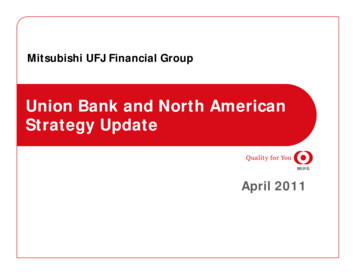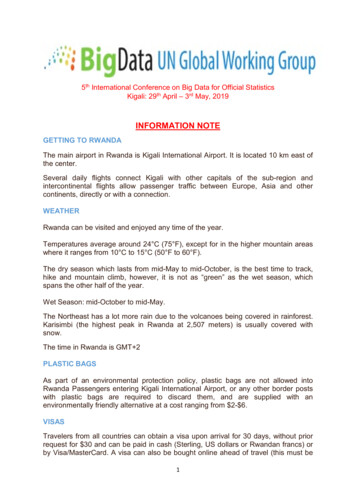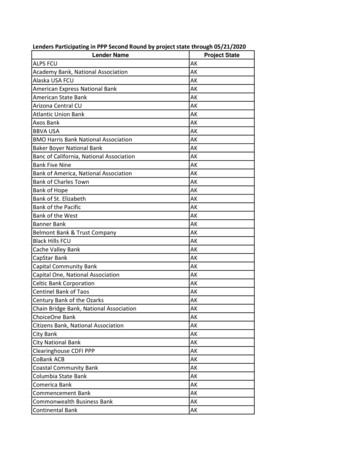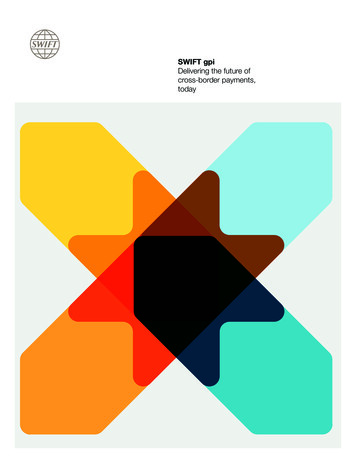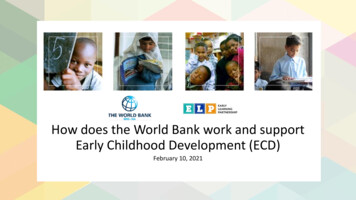
Transcription
How does the World Bank work and supportEarly Childhood Development (ECD)February 10, 2021
Presentation Outline- World Bank Group Structure- Investing in the Early Years to Build Human Capital- How does the World Bank work with countries?- How does the Early Learning Partnership work?- How can you find out more information about the WorldBank’s work in specific countries or globally?
World Bank GroupStructure
Quick note on World Bank Group Structure189 member countries,represented by a Board ofGovernors (generally: membercountries' ministers of finance orministers of development).The governors delegate specificduties to 25 Executive Directors,who work on-site at the Bank.IBRD and IDAmake up the World BankDay-to-day under the direction ofthe president, senior staff, andthe vice presidents in chargeof Global Practices, Cross-CuttingSolutions Areas, regions, andfunctions.
World Bank Group staff16,000 staff worldwideApproximately 50%located in WashingtonDC and 50% located incountry offices.Typically Washington,DC staff visit countryoffices 2-3 times peryear to work onprojects.
Investing in Early ChildhoodDevelopment to Build HumanCapital
Investing in young children is one of the best thingscountries can do to build human capital. Growth and development in the early years form the foundation for future learning,productivity and lifetime success. Interventions that promote child development can take place from before pregnancythrough to a child’s entry to primary school.
A MULTISECTORAL APPROACH TO THE EARLY YEARS (AKA ECD)15
ECD (and Early Years) work occurs across sectors Human Development (HD) within the World Bank includes three sectors: Health, Nutrition and Population (HNP)Education (EDU)Social Protection and Jobs (SPJ)Staff are mapped to these sectors, within regions or globally (we don’t have ECD staff) We have an Early Childhood Development Global Lead (Amanda Devercelli, sittingin education, but working across sectors to promote ECD) We have an Early Years Team of HD staff that works together to ensurecoordination across sectors and promote staff learning: Focal point for HNP (Meera Shekar, who is also the Global Lead for Nutrition)Focal point for SPJ (Laura Rawlings who also sits on the Human Capital Project Team)Focal point for EDU (Amanda Devercelli who is also the Global Lead for ECD)Focal point for the Global Financing Facility for Every Women and Every Child (Leslie Elderwho sits with GFF)
WILL ACCELERATEMORE AND BETTERINVESTMENTSIN PEOPLE GLOBALLY1. Human Capital Index: Make the case forinvestment in the human capital of the nextgeneration.2. Measurement & Research: Improve measurementand research and provide analysis to supportinvestments in human capital formation.3. Country engagement: Support Early Adopters,and ultimately all countries, to prepare nationalstrategies that accelerate progress on humancapital.78 COUNTRIES JOINED BY SEPTEMBER 2020
HUMAN CAPITAL INDEXxSURVIVALChildren who don’t survive don’t growup to become future workersGAINS SINCE2010xSCHOOLContributionof quality-adjusted years of school toproductivity of future workers HEALTHContributionof health (adult survival rate andstunting) to productivity of futureworkersHCIProductivityof a future worker(relative to benchmark of completeeducation and full health)
The World Bank is the largest funder of ECD worldwide andinvestments have grown substantially in last 5 yearsIn Fiscal Year 2020:12IDA/IBRD commitments for IEY (in US billions) IDA/IBRD investments in the earlyyears reached 4.5 billion – aconsistent increase since FY16 anddoubling since FY18 Close to ¼ of commitments are in FCVcountries -- 1.2 billion in FY20 New project commitments haveconsistently been the largest in theAfrica region, followed by LAC andMENA
ECD is increasing in total volume and as ashare of IDA financingIDA 182018 - 2020ECD accounted for 11% ofIDAIDA 172015-2017ECD accounted for6% of IDATotal IDA 17: 52 BnECDOtherTotal IDA 18: 75 BnECDOther
Trust Funds that Support ECD at the World Bank Trust Fund financing for early years investments has averaged almost 250 millionannually over the last three years. Trust funds typically support analytical work and may finance or co-finance projects14Japan Trust Fund for Scaling Up Nutrition Investments
Partnerships and External Engagement SDG 4.2.1 Working GroupNurturing Care FrameworkReach Up Implementors GroupECDAN Executive Leadership Council and regionalefforts with regional ECD networks and IDB UNICEF, UNESCO, WHO and GPE collaboration onvarious pieces of global guidanceglobal guidance Bilateral engagement (especially with FCDO)SD
How does theWorld Bankwork withcountries?
How does the World Bank work with countries?What arethe typesof WBGfinancing? IDA: provides loans, grants and advice to low-income countries IBRD: provides loans and advice to middle-income and some low-income countries WBG also manages grants on behalf of other organizations (e.g. manages the design andimplementation of 75% of all Global Partnership for Education (GPE) grants)Countries are allocated WBfunding from a global poolHow doesthe WBGgroupallocatefinancing?Countries decide towhich sectors theyallocate funds Funding allocated on 3 year cycles Government and WBG agree on Country Partnership Frameworksallocations to sectors, guided by(CPF) guide funding prioritization, the CPFbased on analysis & stakeholder WBG staff work with counterpartsconsultations to identifyand partners to consider prioritiesconstraints to growth and poverty for investment within sectorsreductionWBG staff workwith countries andpartners to designprojects Projects are co-designed by WBGand Government, with input frompartners Projects are implemented by theGovernment WBG provides fiduciary andquality assurance
Some key take-aways on how the WB works: The World Bank is a bank that provides large loans and grants to governments. We are a bank and governments are our clients. It is primarily a demand-driven approach. Projects are co-designed by the WB country sector team and the government, aligned tonational priorities and planning documents. Projects are implemented by the government through government systems (whichcould choose to work with NGOs or other non-state actors in some instances) Environmental and social safeguards and civil society engagement are built into theproject preparation and implementation cycle.
More Takeaways We don’t have ECD staff, so projects and activities will be through specific sectors orthrough cross-sectoral projects Decisions on how financing is allocated are made at the country level by thegovernment, in consultation with the WB country team. So, relationships in countriesmatter. The advantages of this approach include national system strengthening andsubstantial multi-year financing that allows for more sustainable planning and theopportunity to have systems-level impact and operate at scale. Partners should engage directly with governments to influence government decisions. The distinction between evidence-based technical assistance and advice vs. advocacy isan important distinction globally and at country level
Other analytical work ongoingInvesting in the Early Years to Build FutureSkillsHow does theEngaging thenon-state sector in earlyEarlyLearninglearningPartnership (ELP)Over-enrollment reportwork?
A story from Uzbekistan 2011-present day2011: Request from the Government for a short brief on ECD in Uzbekistan identified the followingissues: Dramatic reduction in preschool enrollment to below 20% nationwide Uzbekistan spending 2-3x more on preschool than neighboring countries but getting worse outcomes Cross-sectoral coordination and quality assurance lacking2012: Request for a more in-depth analysis found: Poorer and more rural regions had worse infrastructure, less qualified teachers and worse developmental outcomesWhat was being measured wasn’t very usefulCommunity structures and parents weren’t being engagedUrban areas were oversubscribed and services in rural areas didn’t meet families’ needs2013: Launch of a new project ( 25 million out of a 50 million project with GPE finance) Half-day rural preschool model targeting poorest regions with infrastructure improvements in disadvantaged areasNew quality standards and approaches to measurementCommunity libraries and playgroundsBook distribution to homesEngagement of community leadersEvaluation built into the project2018 onwards ECD unit established within Ministry of Education New innovative Public-Private Partnership model expanding
How doesELP workwithin theWorldBank?Reality: Programming isdecentralized Task Teams haveseverelyconstrainedcountry-levelbudgets Bank staff areoften generalistsworking withcountries withsubstantial timeconstraints CompetingprioritiesThe question: How can we makeit eeaiser forcountries to moveECD up the list ofpriorities?4 ELP Workstreams:1. Catalytic financingto build the pipelineand improve theportfolio qualitythrough countrygrants2. Global and countrylevel analytical workto make the caseand find solutions3. Capacity building(internal andexternal)4. Partnerships andexternalengagement
ELP Footprint and Expansion 2012 to 2020
How does ELP work within the World Bank?What are thetypes of WBGfinancing?How does theWBG groupallocatefinancing?How doesELP supportECD withinthis process? IDA: provides loans, grants and advice to low-income countriesIBRD: provides loans and advice to middle-income and some low-income countriesWBG also manages grants on behalf of other organizations (e.g. manages the design and implementation of Global Partnership forEducation grants)Countries are allocated WB fundingfrom a global poolCountries decide to which sectorsthey allocate funds Funding allocated on 3 year cycles Country Partnership Frameworks (CPF)guide funding prioritization, based onanalysis & stakeholder consultations toidentify constraints to growth andpoverty reduction Government and WBG agree onallocations to sectors, guided by the CPF WBG staff work with counterparts andpartners to consider priorities forinvestment within sectors. Reach out to country teams to identify needs andopportunities Offer grants to WBG teams and governments togenerate evidence and make the case to include ECDin country priorities in CPFs (which then leads toprojects) Generate global knowledge and evidence that can beused to inform country level policy dialogueWBG staff work with countries andpartners to design projects Projects are co-designed by WBG andGovernment, with input from partners Projects are implemented by theGovernment WBG provides fiduciary and qualityassurance Support country teams with technical assistanceduring project design and implementation Fund pilots to make the case for further investment(demonstrate value) or inform projectdesign/implementation Provide global public goods (e.g. guidance notes,measurement tools, etc.) to promote evidence-based,quality programming Capacity building efforts
The ELP Country Grants PortfolioTeam: Ella Humphry and Amanda Devercelli Country grants of 50,000- 200,000 are made to World Bank teams to work with governmentson ECD The ELP has awarded a total of 15.3 million to 117 grants in 57 countries since 2012. The active portfolio includes 70 grants in 46 countries, totaling 8.5 million.Phase 1Phase 2Phase 3TotalOverall portfolio14 grants( 1.1m)47 grants( 10.4m)56 grants( 3.9,m)117 grants( 15.3m)Active portfolioNo grants14 grants,( 4.4 m)56 grants( 3.9 m)70 grants( 8.5m)Sector Breakdown (Active Grants)EDUSPJPovertyHNPGenderCross-sectorRegional Breakdown (Active 0%7%SAR
Thematic Funding Rounds 2019 and 2020Thematic roundChildcareCOVID-19Quality ECENumber and value ofapplications received30( 4.8 million)31( 1.5 million)10( 2.3 million)Number and value ofgrants approved14( 1.3 million)28( 1.1 million)7( 699,000)PlayfulParentingTOTAL1687( 2.7 million) ( 11.3 million)7( 836,0000)56( 3.9 million) Activities funded in these four thematic funding rounds will reach an estimated32.1 million children and 28.7 million parents and train 125,000 ECD workers. The grants are already leveraging 703 million in financing for young children andare expected to leverage more in the future.
Analytical WorkQuality Early Learning: Nurturing Children’s PotentialTeam: Magdalena Bendini, Amanda Devercelli, Elaine Ding, Adelle Pushparatnam, Melissa Kelly Synthesizing the latest evidence from multiple disciplines to identify the crucial elements of effective ECEthat countries should prioritize to provide key actionable, evidence-based and cost-effective strategies forthe delivery of quality ECE at scale. Edited volume, guidance notes and briefs on key topics.Scaling Up Measurement in Early ChildhoodTeam: Adelle Pushparatnam, Diego Luna Bazaldua, Elaine Ding Developing tools to measure child outcomes and the quality of early learning environments at scale, alongwith complementary resources and technical assistance to support roll out across 25 countries Identified a core set of items to directly measure child learning outcomes involving the aggregationand advanced psychometric analysis of data from 14 LMICs worldwide COVID-19 caregiver phone survey (includes refugee populations in Kenya) Teach ECE to be rolled out along with the Teach Primary classroom observation tool to measure thequality of teaching practices within early childhood education settings.
Analytical WorkBetter Jobs and Brighter Futures: Investing in Childcare to Build Human CapitalTeam: Amanda Devercelli and Frances Beaton-Day White paper launch early March Cross-sectoral work program to expand the quantity and improve the quality of childcare work within the WBGportfolioEngaging the Non-State Sector in Early LearningTeam: Frances Beaton-Day and Amanda Devercelli Helping country teams and clients to leverage the nonstate sector to deliver quality ECD services for youngchildren and their families. Analytical and pilot work on integrating ECD into skills and jobs programs. Countryand global-level collaboration with IFC.Early Learning Systems ResearchTeam: Shawn Powers and Amanda Devercelli Cross-country research program focused on country’s early learning systems Focus countries: Ethiopia, Jamaica, Liberia, and the Punjab, Pakistan
Early Years Fellowship:Building the next generation of leaders and expanding WBGcapacity to engage in ECDTeam: Melissa Kelly and Amanda DevercelliLaunched in 2016 to build capacity within countries anddevelop the next generation of leadership to scale-upinvestments in Early Childhood Development (ECD). TheFellowship has three related objectives:1.2.3.Build the capacity of young professionals in countries onECD, reducing reliance on technical assistance from abroadand ensuring a more sustainable, contextually specific andinformed response to the challenges associated with scaleup of ECD services at country level;Improve the quality of ECD analytical work and programimplementation in countries by increasing the number ofexperienced professionals available to advise and supportcountry governments and World Bank teams; andDevelop the next generation of leadership needed at thecountry level to scale-up investments in the early years.
Early Years Fellowship:Building the next generation of leaders and expanding WBGcapacity to engage in ECDSecond cohort of 25 Fellows began work across34 countries as of January 2020 Recruited from 2,500 applicants 25% recruited abroad and returned to theirhome countries to participate 25 languages spoken More than 200 years of combined ECD workexperienceWe’ve invested more in the ProfessionalDevelopment Program through which Fellowsdedicate 20 percent of their time to acustomized program to build technical,operational and professional skills.
Engaging Policymakers in Early ChildhoodTeam: Melissa Kelly, Marcela Gutierrez Bernal and Amanda Devercelli A multi-year effort to engage, repeatedly, with a group of countriesglobally to build policymaker capacity, promote South-South learningand generate positive peer pressure to yield more and better ECEinvestments. Launching with a cohort of 8-12 countries in early 2021 (40 countryrequests to participate so far). Country delegations include a mix of technical level and higher-levelparticipants (along with WBG staff)
EngagingPolicymakersin EarlyChildhood:Program Designadjusted to meetcountry needs
Bangladesh: ELP funding has helped shift policy, generate new funding and willsupport quality improvements while scaling1st ELP grant: 44kawarded 20192nd ELP grant: 99k awarded2020Landscape Assessment revealed impact ofpre-primary and need for qualityimprovements: Children 37% more likely to bedevelopmentally on track if they attended Findingsused topre-primary education Quality of pre-primary educationhampered by a shortage of qualifiedteachers and inadequate curriculum andclassroom practicesActivities include: TA to improve quality andpromote learning throughplay Review current ECE teachertraining curriculum Conduct a survey on teacherand headteacher trainingneedsFindingswill beused to1. Change policies and highlight ECEwithin Bangladesh Education SectorPlan 2021-25 Additional year of preprimary New training and certification forpreprimary teachers and schoolleaders2. Secure funding for ECE within the 59.3 million ESPIG GPE grantProvide evidence to design ESPIG and ensure quality implementation Extra year of preprimary education Advanced certification for preprimary teachers First-time training for head teachers managing ECE
Social protection grantsEducation grantsEthiopia: 5 ELP grants, Early Learning Systems Research work and 3 Early YearsFellows support quality ECD programming at scale using multiple entry points 150k in 2016 to supportproject preparation 50k in 2017 to improveECE qualityExpanding and improving the quality of O classes at scale Early Learning SystemsResearch (ELSR)2 childcare grants in 2019- 180k for a childcarepilot in rural areas- 180k in 2019 for achildcare pilot in urbanareas 43k in 2020 foraccompanying measuresto cash transfers 60m ECE component in GEQUIP-ECoaching and supervision instrumentsfor O classesELSR is providing actionable evidenceon quality interventions: P1: Diagnostic of O classes P2: Evaluating effects of qualityenhancements on O classesPiloting childcare for public works beneficiaries – multiple impacts Improve quality and child outcomes &women’s participation (plus parenting)Leveraging additional funding for IEResults will inform future projects TBDacross sectorsEnhancing early stimulation and parenting at scale during COVID Materials developed for parents enrolled in a Safety Net Program duringCOVID-19 on early stimulation, coping and playful parentingMessages will reach 500,000 households with young childrenEY Fellows helpdeliverinterventions,ensure alignmentwith Governmentand partners andenhance quality Identify ECD gaps &opportunities Improvemultisectorialcoordination Improve dialoguewith governmentand partners Contribute to highquality design andimplementation
Our COVID-19 ECD ResponseThe ECD team mobilized quickly to work with colleagues from across the Bank to ensure young childrenand their families are supported during COVID-19 and that countries and teams have the resources theyneed, including through the following activities:ELP EmergencyCOVID-19 FundingRound: 1.1million to 28countriesInvesting in theEarly Years andCOVID-19Measuring the impact ofCOVID-19 on youngchildren and familiesthrough phone surveys15 Ways to SupportYoung Children andtheir FamiliesDuring the CrisisStaff learning and just-intime technical assistanceon radio, TV and internetfor young children andfamiliesPreschoolReopeningGuidance andInteragencyStatement on ECDEnsuring teamshave expertguidanceActivating andsupporting theEarly YearsFellows
ELP investments catalyze significantly more fundingfrom WB and domestic financing
Questions forHow can you find outdiscussionmore information 250,000 for a specific study with primary data collectionabout the World Bank’swork in countries orglobally? Reduce size of grants, with specific thresholds 100,000 for analytical work 50,000 for project preparation and project implementation Expansion to new regions Who is focusing on children age 0-3? Education GP is subsidizing Early Years across HD
How do I find out what is happening ina country or get information on aspecific project? Go to: https://www.worldbank.org/en/where-we-workand scroll down and click on the country There you will find news stories, latest research,available data and the list of projects Search for the Country Partnership Framework orStrategy You can click on specific projects and get: Project Appraisal DocumentSafeguards assesmentsProcurement plansImplementation Status and Results
Where can you find information on our website?Check out our ECD ldhooddevelopment#1Chek out our Early arsCheck out the Strategic Impact Evaluation Fund (SIEF) st-fundSearch the research pagehttps://www.worldbank.org/en/researchData are worldbank.org/index.cfm?indx 8&pd 6&sub 0
Next sessions and upcoming eventsPlease type your ideas for future sessions in the chat box. We’re thinkingabout these:- Childcare- Gender and ECD- ECD Measurement- ECD in FCV settings- The Early Years Fellowship- Latest impact evaluation evidence on ECD
We have an Early Childhood Development Global Lead (Amanda Devercelli, sitting in education, but working across sectors to promote ECD) We have an Early Years Team of HD staff that works together to ensure coordination across sectors and promote staff learning: Focal point for HNP (Meera Shekar, who is also the Global Lead for Nutrition)






